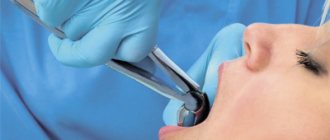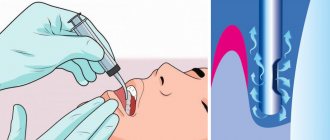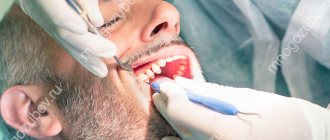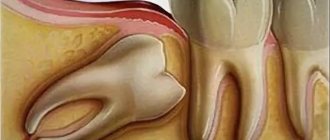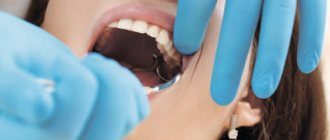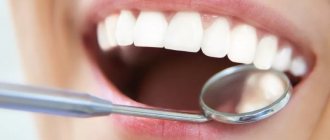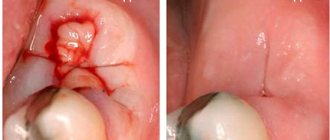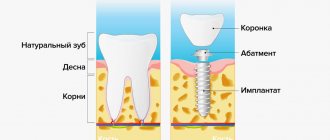If you are planning an implantation or removal of a cyst, be prepared for the fact that the dentist will have to cut into the gum. When an unerupted or incompletely erupted wisdom tooth is removed from the gums, an incision is also inevitable.
After surgery, complications such as swelling, bleeding, and aching pain are possible. The reasons include decreased immunity, infection in the mouth, or improper care during the postoperative period. Therefore, the best thing you can do is to remember and follow all the doctor’s recommendations.
Stages of the operation. How to cut gums in dentistry
No matter how the gum is cut, the procedure is the same:
- Examination and antiseptic treatment of the oral cavity, professional cleaning, and, if necessary, radiography.
- Anesthesia - local or anesthesia.
- Selecting the type of cut and the cut itself.
- Basic treatment methods: installation of a drainage system in the wound to release purulent exudate for up to 3 days, removal of a tumor, cyst, installation of prosthetic elements.
- Stitches are applied and removed within 5–7 days.
Before surgery, preparation is often carried out with immunomodulators, restoratives, anti-inflammatory, and antiallergic drugs. After surgery, antibiotics may be prescribed for 3–5 days due to the risk of purulent inflammation.
There are a number of methods for cutting gums.
A vertical incision from the edge of the gum (gingivotomy) is usually performed for periodontitis.
In flap dissection, a series of horizontal and vertical incisions are made. This type is divided into the following stages:
- coronal displacement with detachment of a tissue flap and covering of the exposed dental root system with it;
- formation of a lateral flap to cover isolated small areas of exposed roots, for example, with periodontal disease;
- the most traumatic V-shaped incision with the addition of donor gum tissue to the resulting flap to cover not only a small, but also a larger area of the exposed root;
- the Ramfjord method for accessing the diseased root - the gum is dissected at the periodontal pocket, the edges of the flap are moved apart and returned to their place after removing the affected tissue;
- cross-shaped incision for flux.
The surgeon chooses the type of incision that is justified in a specific clinical situation.
How is tooth extraction performed?
It all starts with a consultation. The doctor will take a three-dimensional photograph, assess the location of the tooth in the jaw, the number and direction of the roots - wisdom teeth are famous for their unusual anatomy. All other human teeth are classified and have their own standard structure options, while the shape of wisdom teeth is random.
By the way, why wisdom? The point is the timing of the formation of tooth germs. All other teeth are formed in utero and after birth only continue their development and eruption. The formation of figure eights in the jaws occurs at the age of 4-5 years, and the beginning of teething occurs at an older age, hence the connection with wisdom.
After assessing the situation based on the image, you will be scheduled for surgery. At the appointment, the doctor administers anesthesia and removes the tooth. Most often, you need to make a small incision in the gum and cut the tooth into several parts; you can read more in detail here.
After removal, the additional incision is sutured, but the hole itself remains. The doctor inserts a membrane made from the patient’s venous blood into it - before the operation begins, the blood is taken and the tube is sent to a centrifuge, where the membrane is formed. Experience has shown that this will heal better and faster. A blood clot forms in the hole with the membrane, through which it will heal.
How long does it take for gums to heal after an incision? How long does it take for the swelling to go down?
In order for the gums to heal, after surgery a blood clot must form in the wound within 10–12 minutes. It prevents pathogenic bacteria from entering the incision site and after 3-4 hours it is converted into granulation - young gum tissue. Epithelial coverage occurs by 10 days, and healing of the wound occurs within 2–3 weeks. It will heal completely in two months.
Healing times are determined by a number of factors and increase:
- proportional to the volume of surgical trauma;
- with age;
- with low immunity;
- for underlying diseases (diabetes, inflammation, HIV, oncology).
Applying sutures speeds up the healing of the wound edges brought together by the sutures.
How many days the swelling will go down depends on the extent of the operation:
- in case of injury to a large area, the swelling does not subside for several days;
- the presence of purulent inflammation before surgery prolongs the period of tissue swelling until all the pus comes out, so drainage is left in the wound for several days;
- when installing implants or prosthetics, cheek swelling can last up to 1 week, but if it grows or increases pain, you need to consult a dentist - perhaps the installation was incorrect;
- If there are complications, the swelling will not subside and will increase - this is a signal for an urgent visit to the dentist.
A condition where the cheek is swollen after surgery is considered normal if the bump lasts no more than 3-5 days. Otherwise, you need to consult a surgeon.
Gingivoplasty at NovaDent
If you need gum grafting, contact the NovaDent network of clinics. We employ only highly professional doctors with extensive experience in this field (the average experience of a doctor in the clinic is 12 years, the experience of some specialists exceeds 20 years), and in treatment we use the most advanced and current technologies and materials. In addition, we are distinguished by the very favorable cost of gum recession plastic surgery in Moscow, as well as affordable prices for other types of gingivoplasty. Sign up for a free consultation and our specialist will create the optimal treatment program for you.
How to rinse your mouth after a gum incision
Rinsing the mouth after surgery is not done immediately, so as not to wash out the blood clot from the wound.
They use pharmaceutical products: chemical and herbal, as well as those prepared at home.
| Ready-made products | Home Remedies | |
| Chemical | On herbs | |
| Chlorhexidine | Stomatophyte | Infusions: · sage; · chamomile; · oak bark; · calendula; take 1 tbsp. for 1 tbsp. boiling water, leave for 15–30 minutes, strain, cool, add to a volume of 200 ml |
| Miramistin | Maraslavin | Saline or soda-salt solution (1 teaspoon each of soda and salt, preferably sea salt, per 1 cup of water) |
| Furacillin | Rotokan | Light pink solution of potassium permanganate |
In addition to general recommendations, the doctor will advise what to rinse the mouth of a particular patient.
You need to rinse after each meal until swelling and pain disappear. Sometimes the same products are used for applications and lotions on the incision area.
Postoperative period
Very often, patients have gum pain after the removal of a wisdom tooth; you can read more about how dystopic teeth are removed here.
After surgery, the patient may be concerned about the following:
- Pain in the retromolar area;;
- Unpleasant and painful sensations when opening the mouth;
- Discomfort in the oral cavity;
- Swelling and hyperemia of soft tissues;
- Bleeding;
- Swelling and asymmetry of the face;
- Inability to eat food normally;
- Deterioration of general condition: weakness, fever, headache.
Complications after surgery
Complications of gum incisions include:
- fever, indicating current inflammation;
- swelling of the gums;
- boring, burning pain radiating to the jaw bone, ear;
- bleeding 1–2 hours after surgery;
- flux.
Self-medication here is dangerous, since any of the complications may require repeated incision of the gums.
Edema and swelling
Swelling at the wound site for 2–3 days is acceptable. If it spreads to the cheek, this may be a sign of alveolitis - inflammation of the socket, requiring repeated intervention.
Heat
With normal healing, the temperature gradually drops by day 4–5. If it lasts longer and becomes higher, the wound has become infected and a new operation is needed.
Pain
The pain gradually subsides. When it increases, the appearance of a new character, severity, coupled with swelling and high temperature, surgical treatment of a purulent infection is required.
Bleeding
When the gums are cut, bleeding occurs after 1–2 hours. Homemade hemostatic agents are used: hydrogen peroxide, applying a tampon to the wound. If the patient sees that the bleeding does not stop, urgent assistance from a dentist is needed.
Flux
With increased pain and swelling, inflammation can spread to the periosteum of the jaw, and gumboil occurs. Surgical treatment is needed.
Types of coagulation
The operation is performed using two devices: an electrocoagulator or a laser. Using a heated metal tool is an outdated but possible method. Laser therapy is more gentle compared to its predecessors.
Cauterization of gums in dental clinics is carried out using two methods:
- Monopolar. It is performed using an electrical device - a monopolar coagulator. Alternating current with high-frequency oscillations is supplied to the electrode, and through it into the tissue. It then passes through the body and returns to the end plate. In this case, coagulation occurs in a certain area. The procedure is safe and does not have a negative effect on the body.
- Bipolar. The tip of the electrocoagulator is bifurcated and does not have a closing plate. The current only affects the tissue sandwiched between the two ends that supply the electricity.
The bipolar technique is simpler and safer, but can only be used to remove small formations. Monopolar is suitable for all cases, but carries some risks. A burn may occur due to equipment malfunction or medical error. However, modern clinics are equipped with good equipment and experienced doctors, so you should not be afraid of the procedure.
Recommendations after gum incision
After the operation, the dentist will tell you what can and should be done, and what it is better to refrain from.
- Do not eat or drink for 3–4 hours, do not touch the wound with your tongue, and do not rinse your mouth on days 1–3. Baths with antiseptics and application of gel are possible - Solcoseryl, Cholisal, Kamistad, from the 3rd day - rinsing.
- During the week, use gentle, soft food.
- Eliminate physical activity on the 1st day, alcohol and smoking for a week.
- Any warming (bath, sauna, swimming pool, compresses) and cauterizing procedures (alcohol, iodine, brilliant green) are prohibited for a week.
- If you have sutures, you should not open your mouth too much when eating or talking.
- For pain, take a painkiller (Analgin, Ibuprofen, Ketanov), apply cold.
- After a week, as prescribed by the doctor, physical therapy (electrophoresis, UHF, magnetic laser, paraffin applications) is possible, which improves regeneration.
Following the doctor’s recommendations will help avoid complications and ensure rapid healing of the incision on the gum.
What to do
The most correct tactic for parents when they discover an abscess on their child’s gum is to go to a dental clinic. The doctor will conduct an examination and determine his further actions, which will be influenced by the stage of the process (the abscess is just forming, has already formed or has ruptured) and the type of tooth (baby or permanent).
It is best if the child visits the dentist in the early stages of development, when the purulent lump has just appeared, but even after the abscess breaks through, the baby still needs to be taken to the doctor to eliminate the source of infection and prevent the abscess from re-forming in the same place or over adjacent teeth.
Indications and contraindications
The operation is especially in demand for hypertrophic gingivitis. This is an inflammatory gum disease. If left untreated, soft tissue grows, covering the crown of the tooth. The gingival papilla, which is located between adjacent dental units, is most susceptible to hypertrophy.
Coagulation is carried out in the presence of:
- tissue hyperplasia in gingivitis and other diseases;
- neoplasms: hemangiomas, fibromas, warts;
- abnormalities of gingival tissue;
- periodontitis (root canal coagulation);
- inflammation in periodontal pockets during periodontitis;
- caries on the neck, tooth root.
The list of restrictions includes individual intolerance to electric current, acute infections, exacerbation of chronic diseases, terminal stages of diabetes mellitus or other endocrine disorders, severe pathologies of the heart and blood vessels.
